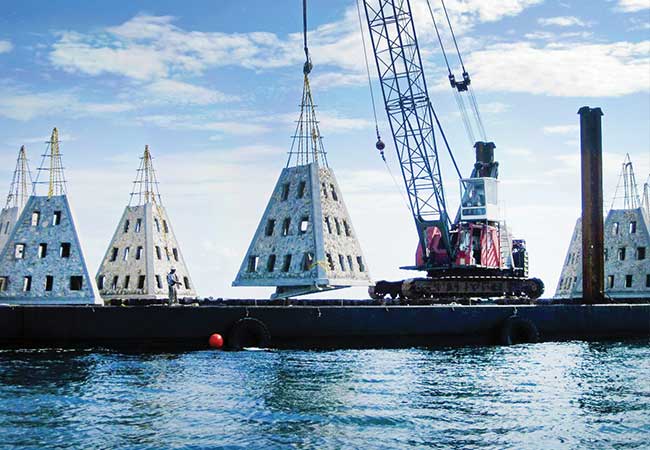By David Rainer, ADCNR
Those who wonder why anglers off Alabama catch more than 30 percent of the red snapper in the Gulf of Mexico despite having only 53 miles of coastline should have attended the recent Red Snapper Conference in Mobile.
The key to Alabama’s phenomenal red snapper fishing is the more than 1,000 square miles just off the coast that are designated artificial reef zones.
During the day-long conference, numerous scientists and fisheries biologists discussed reef fish management, habitat requirements, red snapper and triggerfish recruitment and growth. All those components are tied to Alabama’s reef zones.
Craig Newton, Alabama’s Artificial Reefs Program coordinator, provided those in attendance a comprehensive look at the state’s artificial reefs program, from its unofficial start to today’s highly regulated deployment protocols. Alabama has the largest artificial reef system in the country and has created noticeable improvements in the fishery.
Newton said the artificial reef story off Alabama started in 1953 when 200 car bodies were cabled together and deployed in two segments by the Orange Beach and Dauphin Island fishing communities. In 1961, the U.S. Army Corps of Engineers designated the “Snapper Banks” as the first artificial reef zones off Alabama.
The first deployment by the Conservation Department occurred when five 415-foot Liberty ships, known as the Ghost Fleet in the Mobile-Tensaw Delta, were hauled offshore and sunk in 1974.
The Marine Resources Division (MRD) strategy then changed to creating artificial reef zones instead of individual reef sites. The Corps permitted the first reef zone of 364 square miles in 1978. This is the first area where individuals could deploy MRD-approved reef material.
“What’s unique about this is these privately deployed reefs remain unpublished,” Newton said.
The Hugh Swingle reef zone of 86 square miles followed before another expansion occurred in 1989 with another 245-square-mile reef zone. In a program called Reef-Ex, 100 M60 decommissioned battle tanks were thoroughly cleaned and deployed in the Gulf for reefs in 1993. The Corps granted another expansion in 1997 with a permit for 336 square miles for reef zones. MRD teamed with the Orange Beach Fishing Association on the Red Snapper World Championship from 2004 through 2007 to deploy about 1,000 artificial reefs.
Since then, the focus has moved nearshore with a 1.6-square-mile zone permitted just inside the 3-mile state boundary.
The latest artificial reef zones were permitted last year. A total of 30 square miles inside the 9-mile boundary for reef fish management was approved after an arduous permitting process.
Newton said acquiring a permit for reef zones from the U.S. Army Corps of Engineers has grown increasingly more complex through the years.
Now a reef zone permit application must go to the Corps of Engineers and ADEM (Alabama Department of Environmental Management) for consideration. The application must include detailed construction techniques and methods as well as defined boundaries. A 30-day public comment period required by the Corps is followed by an additional 15-day comment period for ADEM.
Because these are federally authorized permits, they also fall under the National Historical Preservation Act, which is the costliest factor in the permitting process. A Phase 1 archeological survey must be conducted using remote sensing techniques, and it must be proven that the project doesn’t harm threatened species or compromise the critical habitat. The permitting process takes from 20 to 42 months.
The material allowed for reef deployment has changed as well. White appliances, like washing machines and refrigerators, are no longer used. Vehicles and anything fiberglass are also banned. Now, material made of concrete, steel and natural rock are allowed. Chicken transport devices are used as well as concrete pyramids and other structures constructed specifically to provide the best habitat for reef fish.
The Rigs to Reefs program takes advantage of the federal “Idle Iron” regulations, which require oil and gas structures to be removed within five years of the last date of production. The reef program takes obsolete petroleum platforms and uses the structures for reefs.
“We have a diverse assemblage of reef types in our reef zones,” Newton said. “We have 1,282 reefs deployed by the state that are published in our reef program. What makes our reef zones unique is we have the permitted authorization to authorize the public to build their own reefs and the locations remain unpublished.
“We estimate there are more than 10,000 reefs off the shore of Alabama. About 12 percent of those structures are public reefs.”
Newton said about 42 percent of the reef structures are in the zones that have depths from 60 to 120 feet. About 28 percent of the reefs are in depths of 120 to 180 feet. Only 4 percent are deeper than 180 feet.
“What’s really important, you look at relative contribution of these artificial structures in deeper water,” he said. “We have very little natural bottom, natural rock, offshore of Alabama. The natural reefs we do have occur in these deeper waters. This aligns with our goals of avoiding natural reefs when we are deploying artificial reefs.”
Newton said a downward trend in reef deployment by the public coincides with the reduction in the public’s access to the fishery with the shorter and shorter seasons.
“From the mid 90s to the mid 2000s, we permitted about 1,000 reefs per year,” he said. “Now we’re permitting a fraction of that.”
When Marine Resources developed a model to look at the future of the reef system off Alabama, it provided a stark reality.
“What we see is the existing reefs are not going to last forever,” Newton said. “The usable life is about 10 years for regular structures, about 30 for the concrete pyramids. The model shows a steady decline of available habitat into the future. That is why it is imperative that we continue to build reefs on an ongoing basis.”


